常用动词(词组)用法区别
provide,supply,offer的词组,用法差别[赏析]
![provide,supply,offer的词组,用法差别[赏析]](https://img.taocdn.com/s3/m/36caaf1977c66137ee06eff9aef8941ea76e4b1e.png)
Provide ,supply ,offer的词组,用法区别Provide ,supply ,offer的词组,用法区别offer: 常用词,意为" 提出,提供,呈现",表示向别人提供可接受也可拒绝的某物,如帮助,服务或物品,这可能是对方要求也可能是自己主动提出的。
offer to help sb. offer sb. sth./ offer sth. to sb.provide: "供给,提供,装备,准备",强调有预见,并通过储存或准备的方式为某事做准备,以在需要时提供所需物品。
常用词组:provide sb. with sth./ provide sth. for sb. 提供生活费,养活,为……做准备。
例如:supply: "供给,补充,弥补",着重表示替换或不足所需之物以及弥补缺陷,满足要求的意思,还可作名词,意为“供给(量),物资,存货”。
provide动词 v. 供给;供应supply (something needed or useful)· This has provided valuable data for work in soil improvement.这为土壤改良工作提供了宝贵资料。
· I';ll provide food for the picnic.我提供野餐吃的食物。
· If you want to go camping, we can provide you with a tent.如果你们去野营,我们可以提供给你们一顶帐篷。
· You must be provided with warm clothes for the winter.你必须准备好暖和的衣服过冬。
动词 v. 准备;做必须之事;防备make ready,do what is necessary; take steps to preserve oneself from· In our plans for the journey, we have provided for possible accidents.在旅行计划中,我们为可能发生的意外事件作了适当的准备。
常见动词不定式词组、句型用法总结
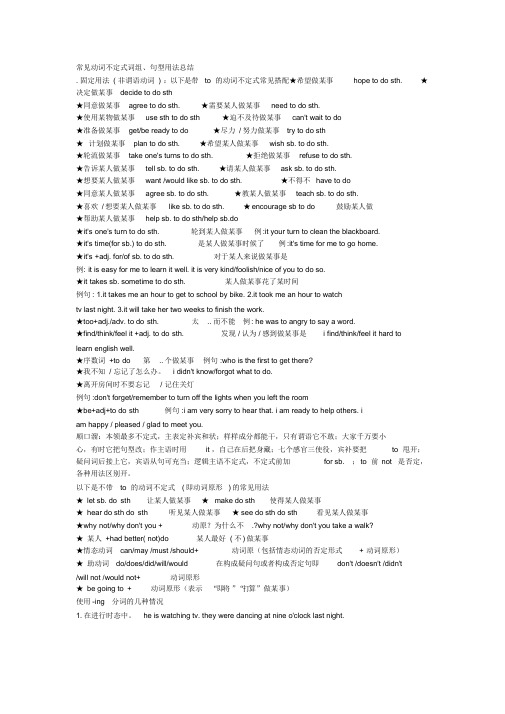
常见动词不定式词组、句型用法总结. 固定用法( 非谓语动词) :以下是带to 的动词不定式常见搭配★希望做某事hope to do sth. ★ 决定做某事decide to do sth★同意做某事agree to do sth. ★需要某人做某事need to do sth.★使用某物做某事use sth to do sth ★迫不及待做某事can't wait to do★准备做某事get/be ready to do ★尽力/ 努力做某事try to do sth★计划做某事plan to do sth. ★希望某人做某事wish sb. to do sth.★轮流做某事take one's turns to do sth. ★拒绝做某事refuse to do sth.★告诉某人做某事tell sb. to do sth. ★请某人做某事ask sb. to do sth.★想要某人做某事want /would like sb. to do sth. ★不得不have to do★同意某人做某事agree sb. to do sth. ★教某人做某事teach sb. to do sth.★喜欢/ 想要某人做某事like sb. to do sth. ★encourage sb to do 鼓励某人做★帮助某人做某事help sb. to do sth/help sb.do★it's one's turn to do sth. 轮到某人做某事例:it your turn to clean the blackboard.★it's time(for sb.) to do sth. 是某人做某事时候了例:it's time for me to go home.★it's +adj. for/of sb. to do sth. 对于某人来说做某事是例: it is easy for me to learn it well. it is very kind/foolish/nice of you to do so.★it takes sb. sometime to do sth. 某人做某事花了某时间例句: 1.it takes me an hour to get to school by bike. 2.it took me an hour to watchtv last night. 3.it will take her two weeks to finish the work.★too+adj./adv. to do sth. 太.. 而不能例: he was to angry to say a word.★find/think/feel it +adj. to do sth. 发现/ 认为/ 感到做某事是i find/think/feel it hard tolearn english well.★序数词+to do 第.. 个做某事例句:who is the first to get there?★我不知/ 忘记了怎么办。
动词词组及词义辨析
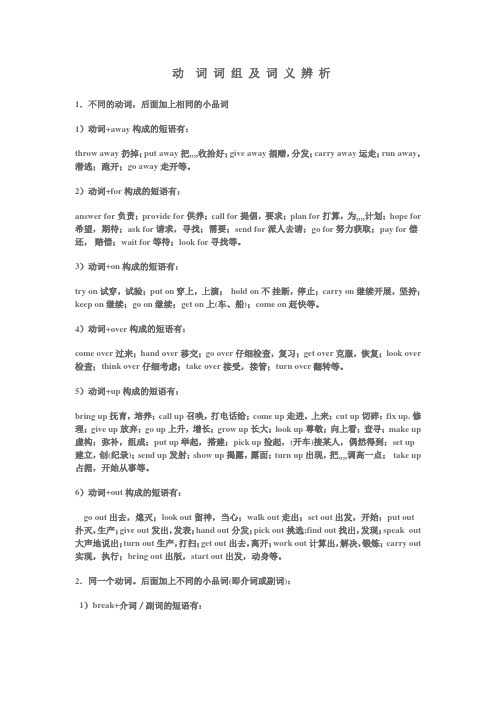
动词词组及词义辨析1.不同的动词,后面加上相同的小品词1)动词+away构成的短语有:throw away扔掉;put away把……收拾好;give away捐赠,分发;carry away运走;run away,潜逃;跑开;go away走开等。
2)动词+for构成的短语有:answer for负责;provide for供养;call for提倡,要求;plan for打算,为……计划;hope for 希望,期待;ask for请求,寻找;需要;send for派人去请;go for努力获取;pay for偿还,赔偿;wait for等待;look for寻找等。
3)动词+on构成的短语有:try on试穿,试验;put on穿上,上演;hold on不挂断,停止;carry on继续开展,坚持;keep on继续;go on继续;get on上(车、船);come on赶快等。
4)动词+over构成的短语有:come over过来;hand over移交;go over仔细检查,复习;get over克服,恢复;look over 检查;think over仔细考虑;take over接受,接管;turn over翻转等。
5)动词+up构成的短语有:bring up抚育,培养;call up召唤,打电话给;come up走进,上来;cut up切碎:fix up. 修理;give up放弃;go up上升,增长;grow up长大;look up尊敬;向上看;查寻;make up 虚构;弥补,组成;put up举起,搭建;pick up捡起,(开车)接某人,偶然得到;set up建立,创(纪录);send up发射;show up揭露,露面;turn up出现,把……调高一点;take up 占据,开始从事等。
6)动词+out构成的短语有:go out出去,熄灭;look out留神,当心;walk out走出;set out出发,开始:put out扑灭,生产;give out发出,发表;hand out分发;pick out挑选;find out找出,发现;speak out 大声地说出;turn out生产,打扫;get out出去,离开;work out计算出,解决,锻炼; carry out 实现,执行;bring out出版,start out出发,动身等。
高中英语语法-动词及动词词组
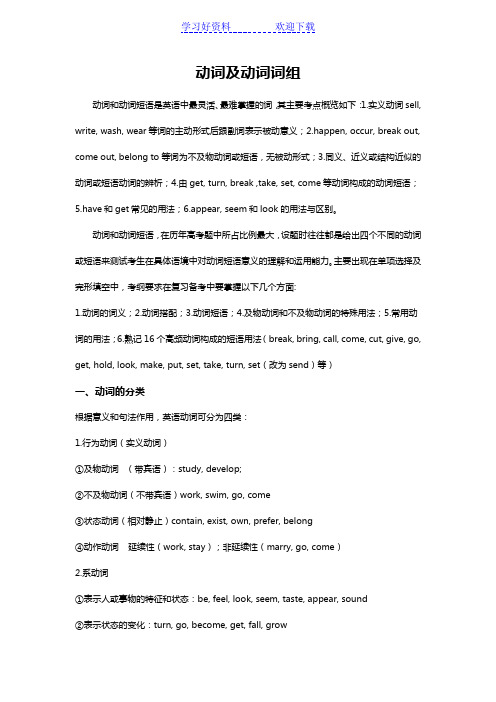
动词及动词词组动词和动词短语是英语中最灵活、最难掌握的词,其主要考点概览如下:1.实义动词sell, write, wash, wear等词的主动形式后跟副词表示被动意义;2.happen, occur, break out, come out, belong to等词为不及物动词或短语,无被动形式;3.同义、近义或结构近似的动词或短语动词的辨析;4.由get, turn, break ,take, set, come等动词构成的动词短语;5.have和get常见的用法;6.appear, seem和look的用法与区别。
动词和动词短语,在历年高考题中所占比例最大,设题时往往都是给出四个不同的动词或短语来测试考生在具体语境中对动词短语意义的理解和运用能力。
主要出现在单项选择及完形填空中,考纲要求在复习备考中要掌握以下几个方面:1.动词的词义;2.动词搭配;3.动词短语;4.及物动词和不及物动词的特殊用法;5.常用动词的用法;6.熟记16个高频动词构成的短语用法(break, bring, call, come, cut, give, go, get, hold, look, make, put, set, take, turn, set(改为send)等)一、动词的分类根据意义和句法作用,英语动词可分为四类:1.行为动词(实义动词)①及物动词(带宾语):study, develop;②不及物动词(不带宾语)work, swim, go, come③状态动词(相对静止)contain, exist, own, prefer, belong④动作动词延续性(work, stay);非延续性(marry, go, come)2.系动词①表示人或事物的特征和状态:be, feel, look, seem, taste, appear, sound②表示状态的变化:turn, go, become, get, fall, grow③表示某种状态的延续或持续:remain, keep, stay3.助动词(与动词原形或分词构成复合谓语):be(am,is,are),do(does,did);have(has);will,would,shall4.情态动词:can(could),may(might),must,shall(should)二、动词及动词短语(一)动词词义辨析动词是是各类考试的重点,高考试题中,单项填空、完形填空和改错等三项题型中,动词辨义的比重较大,并逐年增加。
常见动词不定式词组、句型用法总结
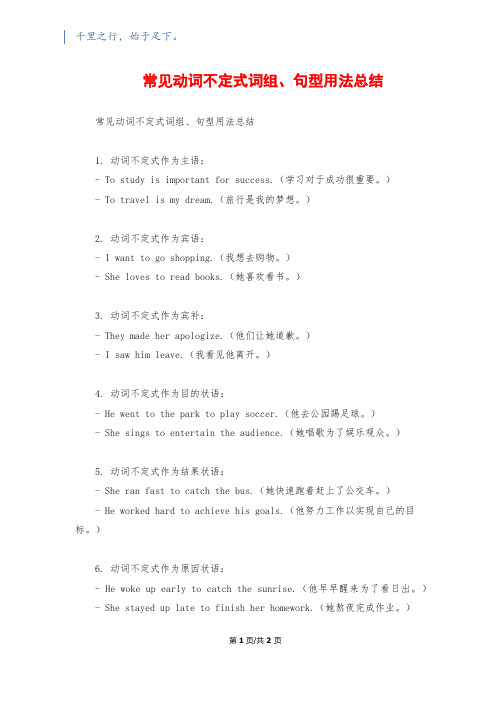
千里之行,始于足下。
常见动词不定式词组、句型用法总结常见动词不定式词组、句型用法总结1. 动词不定式作为主语:- To study is important for success.(学习对于成功很重要。
)- To travel is my dream.(旅行是我的梦想。
)2. 动词不定式作为宾语:- I want to go shopping.(我想去购物。
)- She loves to read books.(她喜欢看书。
)3. 动词不定式作为宾补:- They made her apologize.(他们让她道歉。
)- I saw him leave.(我看见他离开。
)4. 动词不定式作为目的状语:- He went to the park to play soccer.(他去公园踢足球。
)- She sings to entertain the audience.(她唱歌为了娱乐观众。
)5. 动词不定式作为结果状语:- She ran fast to catch the bus.(她快速跑着赶上了公交车。
)- He worked hard to achieve his goals.(他努力工作以实现自己的目标。
)6. 动词不定式作为原因状语:- He woke up early to catch the sunrise.(他早早醒来为了看日出。
)- She stayed up late to finish her homework.(她熬夜完成作业。
)第1页/共2页锲而不舍,金石可镂。
7. 动词不定式作为条件状语:- If you want to succeed, you must work hard.(如果你想成功,你必须努力。
)- You have to practice every day to improve your English.(你必须每天练习才能提高英语。
)8. 动词不定式作为伴随状语:- She listened to music to relax.(她听音乐放松。
动词和动词短语

动词和动词短语一、系动词1.表示人或事物特征和状态的系动词,如smell,live,look,sound,feel,seem,appear等。
例如:The actor looked his part.那个演员看上去和他演的角色很相称。
He appears fl normal person.他看来是一个正常人。
2.表示状态的变化,如go,grow,run,turn,become,wash,get,turn OUt,come等。
例如:His dream has come true.他的梦想成真了。
The river went dry.河流干涸了。
3.表示某种状态的持续或延续,如last,stand,lie,keep,stay,continue,hold等。
例如:He stayed young.他依然年轻。
He told me to keep calm under all circumstances.他告诉我在任何情况下都要保持镇静。
注意:常用系动词及与之搭配的形容词:①feel:sorry,lonely,proud,shy。
happy等。
②get:late,fat,dark,worse,angry,well等。
③go:hungry,bad,lame,broken,mad,blind等。
④grow:worse,calm,cold,old,thin,big,fat,dark 等。
⑤keep:calm,fine,quiet,warm,happy等。
⑥look:strong,tired,fit,nervous,friendly,pretty,excellent等。
⑦remain:single,unmarried,calm,open,active,silent 等。
⑧prove:false,correct,easy,difficult,useful等。
⑨turn:yellow,grey,pale,red,black,green,cold等。
容易混淆的常用动词辨析
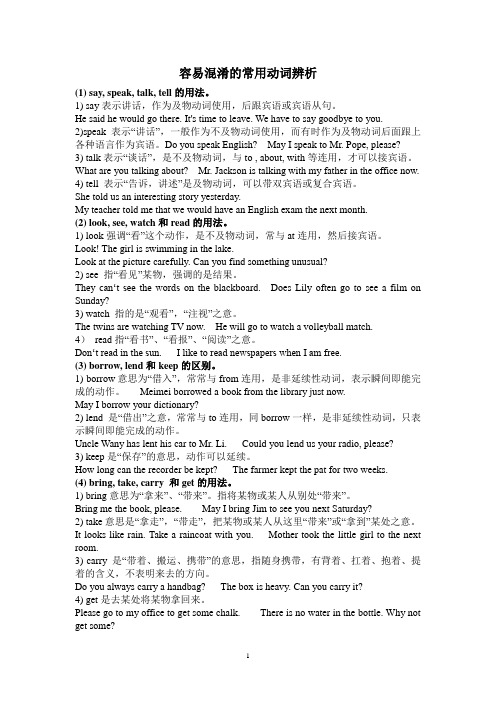
容易混淆的常用动词辨析(1) say, speak, talk, tell的用法。
1) say表示讲话,作为及物动词使用,后跟宾语或宾语从句。
He said he would go there. It's time to leave. We have to say goodbye to you.2)speak表示“讲话”,一般作为不及物动词使用,而有时作为及物动词后面跟上各种语言作为宾语。
Do you speak English? May I speak to Mr. Pope, please?3) talk表示“谈话”,是不及物动词,与to , about, with等连用,才可以接宾语。
What are you talking about? Mr. Jackson is talking with my father in the office now.4) tell 表示“告诉,讲述”是及物动词,可以带双宾语或复合宾语。
She told us an interesting story yesterday.My teacher told me that we would have an English exam the next month.(2) look, see, watch和read的用法。
1) look强调“看”这个动作,是不及物动词,常与at连用,然后接宾语。
Look! The girl is swimming in the lake.Look at the picture carefully. Can you find something unusual?2) see 指“看见”某物,强调的是结果。
They can‘t see the words on the blackboard. Does Lily often go to see a film on Sunday?3) watch 指的是“观看”,“注视”之意。
(用)动词一些常用行为动词和词组的用法与比较示例
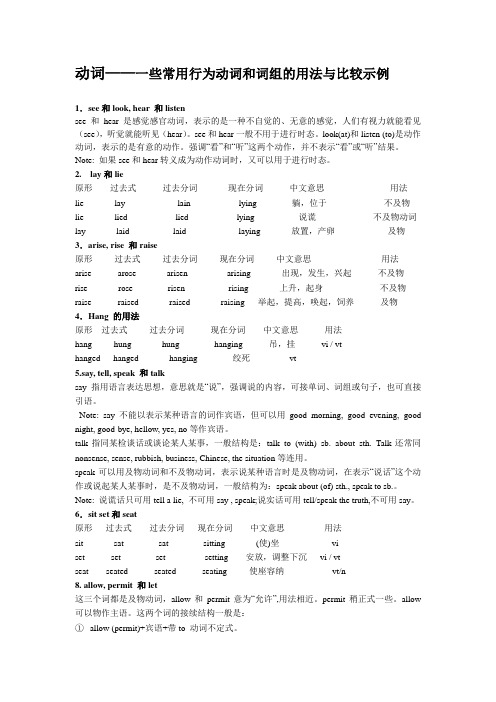
动词——一些常用行为动词和词组的用法与比较示例1.see和look, hear 和listensee和hear 是感觉感官动词,表示的是一种不自觉的、无意的感觉,人们有视力就能看见(see),听觉就能听见(hear)。
see和hear一般不用于进行时态。
look(at)和listen (to)是动作动词,表示的是有意的动作。
强调“看”和“听”这两个动作,并不表示“看”或“听”结果。
Note: 如果see和hear转义成为动作动词时,又可以用于进行时态。
2. lay和lie原形过去式过去分词现在分词中文意思用法lie lay lain lying 躺,位于不及物lie lied lied lying 说谎不及物动词lay laid laid laying 放置,产卵及物3.arise, rise 和raise原形过去式过去分词现在分词中文意思用法arise arose arisen arising 出现,发生,兴起不及物rise rose risen rising 上升,起身不及物raise raised raised raising 举起,提高,唤起,饲养及物4.Hang 的用法原形过去式过去分词现在分词中文意思用法hang hung hung hanging 吊,挂vi / vthanged hanged hanging 绞死vt5.say, tell, speak 和talksay 指用语言表达思想,意思就是“说”,强调说的内容,可接单词、词组或句子,也可直接引语。
Note: say 不能以表示某种语言的词作宾语,但可以用good morning, good evening, good night, good-bye, hellow, yes, no等作宾语。
talk指同某检谈话或谈论某人某事,一般结构是:talk to (with) sb. about sth. Talk还常同nonsense, sense, rubbish, business, Chinese, the situation等连用。
常见动词短语辨析

常见动词短语辨析常见动词词组归纳辨析常见动词短语归纳辨析在英语学习中,我们会遇到大量的动词短语,短语不同于单词,它的意思因其相互之间的搭配不同而千变万化,绝不可望文生义。
掌握动词短语的意义以其用法对英语听说、阅读、写作的提高有极其重要的作用,因此,动词短语也是历年高考中的热点之一。
笔者深入研究了高中新教材新课标,精心整理近年教学的积累。
在高中新教材中所有同义、易混、相似的常用动词短语基础上适当扩展,归纳整合了如下十四个常见动词的短语。
希望能对大家的学习有所帮助。
一、BREAK1. break away(from) 突然离开,放弃;(与……)脱离eg: The wing of the plane broke away in mid-air and the plane crashed. 机翼在空中脱落,飞机坠落了。
Can’t you break away from old hab its? 你不能戒除旧习惯吗?2. break down vi.损坏;(汽车)抛锚;失败vt.分解(强调物理变化)eg: Negotiations have broken down. 谈判已经破裂了。
The car/ engine broke down. 汽车/引擎坏掉了。
Sugar and starch are broken down in the stomach.糖和淀粉在胃里被分解。
A better method is to take the waste far out to the sea in ships where the wind and waves break it down. 一个较好的办法是用船把废物运到远海,利用那里的海风和海浪分解这些物质。
3. break in/into 闯入,打断,开始工作eg: His house was broken into in the midnight.半夜有人闯入他家。
高考英语词法系列:动词和动词短语
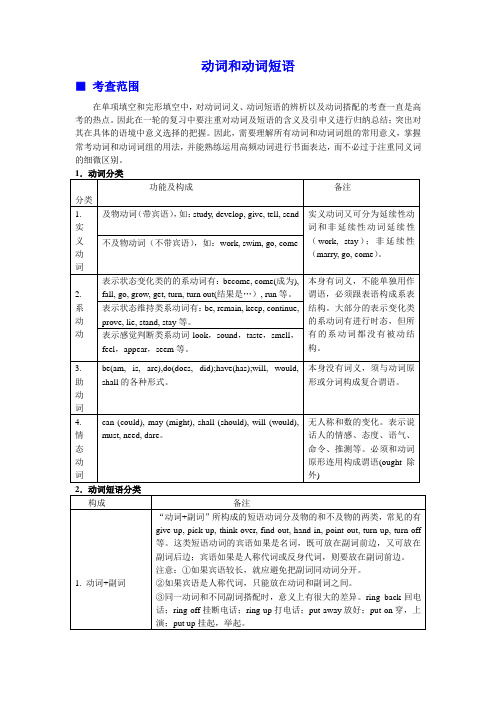
动词和动词短语■考查范围在单项填空和完形填空中,对动词词义、动词短语的辨析以及动词搭配的考查一直是高考的热点。
因此在一轮的复习中要注重对动词及短语的含义及引申义进行归纳总结;突出对其在具体的语境中意义选择的把握。
因此,需要理解所有动词和动词词组的常用意义,掌握常考动词和动词词组的用法,并能熟练运用高频动词进行书面表达,而不必过于注重同义词的细微区别。
■高频考点高考对动词的考查重点集中在实义动词的常见意义和用法,而对助动词的考查较少。
对动词短语的考查重点是第1~3项,而考查第4~6项的情况较少。
高考试题分析■真题探究1.(2010安徽)No matter how low you consider yourself, there is always someone ______you wishing they were that highA. getting rid ofB. getting along withC. Looking up toD. looking down upon【答案与解析】C getting rid of意为“摆脱;去除”;getting along with意为“与……相处;进展”;Looking up to意为“尊敬;敬仰”;looking down upon意为“看不起;轻视”。
句意为“你无论认为自己怎样低下, 总希望有个高尚的人来尊敬你。
”2. (2010全国Ⅰ)The workers ______ the glasses and marked on each box “ This Side Up”A. carriedB. deliveredC. pressedD. packed【答案与解析】D 句意:工人们把玻璃制品包装好并且每个盒子上标记上“此面向上”。
选项为四个意思上毫无关联的动词, 此题考查动词的词义辨析。
carry 译为搬运, deliver译为递送, press译为按, 压, pack译为打包。
常用动词注意及常用短语动词归纳

常用动词注意及常用短语动词归纳常用动词注意事项一、主动表被动的情况1. 感观系动词,look, seem, sound, feel, smell, taste等eg. The fish tastes nice.2. measure, weigh等表示度量的动词。
eg. The elephant weights nearly a ton.3. wash, clean, open, sell, read, last, write, steer等不及物动词可以表示被动意义。
eg. The ship steer easily.二、被动句表示主动含义。
She was dressed in a red skirt.此类动词常见于dress, seat, devote, adapt, accustom 等后面可以接反身代词的动词。
三、时态,语态1. 用进行时表示一种情绪。
She is always helping others.(表赞扬)The man is always smoking in the office, which offends others very much.2. 一般过去时表示某一动作已完成,过去进行时表示动作可能未完成。
He wrote a letter yesterday morning.(信已写完)He was writing a letter yesterday evening. (信可能还未写完)3.现在完成时可表示动作持续至今,一般过去时则表示动作已结束,并不强调对现在造成的影响或结果。
I have lived in this street.(我一直住这条街上)I lived in this street.(我曾住在这条街上)4.表示几个连续动作时,尽管有先后,仍要用相同时态。
He came into the classroom, put down the book and wrote a few words on the blackboard.5. 在条件和时间状语从句中常用一般时表示将来。
初中英语动词的分类知识及语法速记口诀
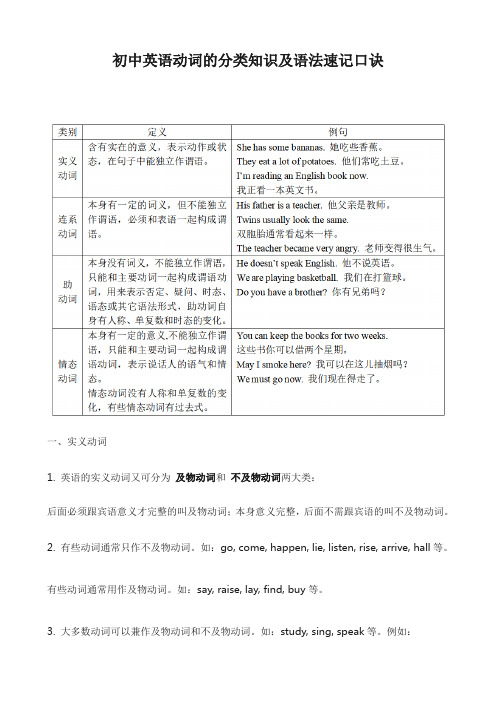
初中英语动词的分类知识及语法速记口诀一、实义动词1. 英语的实义动词又可分为及物动词和不及物动词两大类:后面必须跟宾语意义才完整的叫及物动词;本身意义完整,后面不需跟宾语的叫不及物动词。
2. 有些动词通常只作不及物动词。
如:go, come, happen, lie, listen, rise, arrive, hall等。
有些动词通常用作及物动词。
如:say, raise, lay, find, buy等。
3. 大多数动词可以兼作及物动词和不及物动词。
如:study, sing, speak等。
例如:Who is going to speak at the meeting?谁打算在会上发言?(speak作不及物动词)Few people outside China speak Chinese.在中国以外很少人讲汉语。
(speak作及物动词)4. 有些动词作及物动词与作不及物动词时的意义有所不同。
如:know, wash等。
例如:It’s your turn to wash dishes.轮到你洗碗了。
I had to wash and dress in a hurry.我得赶紧洗漱穿衣。
5. 有些动词常和介词、副词或其它词类一起构成固定词组,形成短语动词。
如:listen, reply, wait, look等。
二、连系动词连系动词用来连接主语和表语,连系动词后面常为形容词。
1. 表示“是”的动词be。
这个词在不同的主语后面和不同的时态中有不同的形式,is,am,are,was,were,have / has been等要特别予以注意。
例如:He is a teacher.他是个教师。
We are Chinese.我们是中国人。
2. 表示“感觉”的词,如look(看起来),feel(觉得,摸起来),smell(闻起来),sound(听起来),taste(尝起来)等。
例如:She looked tired.她看一去很疲劳。
常见动词短语搭配

常见动词短语搭配1.break短语:break away (from sb./sth.)(脱离,逃脱,甩掉);break one’s word(食言);break out(爆发,突然开始,主语多为war,fire,quarrel等,不能用于被动语态);break down(机器、车辆等坏掉,使分解);break in(插话,强行进入);break into(强行闯入,突然开始);break up(粉碎,关系破裂,垮掉);break the rules(违反规定,相反含义的有obey the rules);break the record(打破记录,相当于set up a record,相反含义的有hold a record);break the silence(打破沉默)2.bring短语:bring forth(生产);bring forward(将……提前,提议);bring down(降低,打落);bring in(赚得,提出,引进);bring up(抚养,提出,呕吐).bring sb. convenience/trouble(给某人带来方便/麻烦)3.call短语:call at someplace(拜访某地,相当于drop in at someplace);call on sb.(拜访某人,相当于drop in sb.call for(需要,要求,接);call on/upon sb. to do sth.(请求某人做某事)4.get短语:get along/on with(与……和睦相处,进展);get down to sth,(开始做某事,如:get down to business言归正传);get in(收割,买进);get on(进展,获得成功,对付);get off(下班,出发);get through(用完,顺利通过,接通电话);get to(到达,使烦恼);get up(起床,增强);get in touch with(与……取得联系);get rid of(摆脱);get into trouble(惹麻烦)5.give短语:give in(投降,让步);give up(放弃,投降);give out(散发,耗尽,如:My patience finally gave out:我终于忍无可忍了。
初中英语常用短语动词搭配以及辨析

初中英语常用短语动词搭配以及辨析本文为您提供初中英语常用短语动词搭配以及它们的辨析。
掌握这些动词搭配可以帮助您更准确地运用英语表达。
- go to: 去某个地方(一般是到一个特定的地点)- go at: 去到某个时间或地点2. take/give + advice- take advice: 接受建议- give advice: 给予建议3. make/do + a decision- make a decision: 做出决定- do a decision: 错误用法,应改为 "make a decision"4. look/watch/see + a movie- look at a movie: 错误用法,应改为 "watch a movie" - see a movie: 看电影5. need/want/require + help- need help: 需要帮助- want help: 想要帮助- require help: 需要帮助(通常指特定的要求)6. listen/hear + to- listen to: 听某个声音或音乐- hear: 听到某个声音7. take/give + a test- take a test: 参加一次考试- give a test: 发布一次考试8. do/make + your best- do your best: 尽力而为- make your best: 错误用法,应改为 "do your best"以上是初中英语常用的一些动词搭配以及它们的辨析。
希望对您的学习有所帮助!。
动词及动词词组考点透析
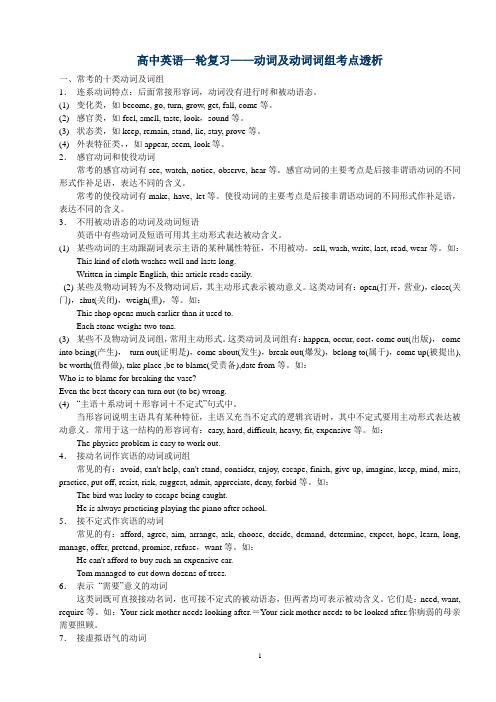
高中英语一轮复习——动词及动词词组考点透析一、常考的十类动词及词组1.连系动词特点:后面常接形容词,动词没有进行时和被动语态。
(1) 变化类,如become, go, turn, grow, get, fall, come等。
(2) 感官类,如feel, smell, taste, look,sound等。
(3) 状态类,如keep, remain, stand, lie, stay, prove等。
(4) 外表特征类,,如appear, seem, look等。
2.感官动词和使役动词常考的感官动词有see, watch, notice, observe, hear等。
感官动词的主要考点是后接非谓语动词的不同形式作补足语,表达不同的含义。
常考的使役动词有make, have, let等。
使役动词的主要考点是后接非谓语动词的不同形式作补足语,表达不同的含义。
3.不用被动语态的动词及动词短语英语中有些动词及短语可用其主动形式表达被动含义。
(1) 某些动词的主动跟副词表示主语的某种属性特征,不用被动。
sell, wash, write, last, read, wear等。
如:This kind of cloth washes well and lasts long.Written in simple English, this article reads easily.(2) 某些及物动词转为不及物动词后,其主动形式表示被动意义。
这类动词有:open(打开,营业),close(关门),shut(关闭),weigh(重),等。
如:This shop opens much earlier than it used to.Each stone weighs two tons.(3) 某些不及物动词及词组,常用主动形式。
这类动词及词组有:happen, occur, cost,come out(出版),come into being(产生),turn out(证明是),come about(发生),break out(爆发),belong to(属于),come up(被提出), be worth(值得做), take place ,be to blame(受责备),date from等。
英语常用易混淆单词词组的区别用法(9组)
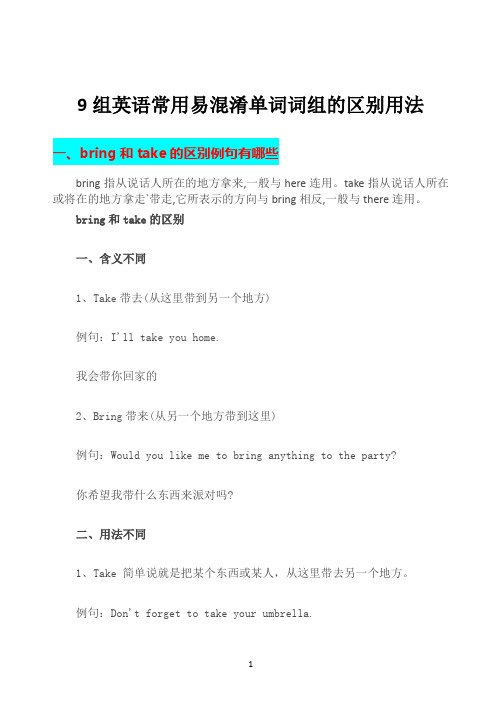
9组英语常用易混淆单词词组的区别用法一、bring和take的区别例句有哪些bring指从说话人所在的地方拿来,一般与here连用。
take指从说话人所在或将在的地方拿走`带走,它所表示的方向与bring相反,一般与there连用。
bring和take的区别一、含义不同1、Take带去(从这里带到另一个地方)例句:I'll take you home.我会带你回家的2、Bring带来(从另一个地方带到这里)例句:Would you like me to bring anything to the party?你希望我带什么东西来派对吗?二、用法不同1、Take 简单说就是把某个东西或某人,从这里带去另一个地方。
例句:Don't forget to take your umbrella.别忘记带走你的伞。
2、Bring 简单说就是把某个东西,从另一个地方带来这里。
例句:Would you like me to bring anything to the party?你希望我带什么东西来派对吗?三、主动性不同1、take可以表示主动的移动。
例句:I'm taking the kids to the cinema tonight.今晚我要带孩子们去看电影。
2、bring则表示跟随一起移动。
例句:Would you like to come with usand bring Susie?你愿意和我们带上苏西跟我们去吗?二、anybody和anyone的区别及用法anybody和anyone相同处是都可以指人,”任何人",或疑问句否定句的的 "某个人"。
不同处是 anybody只能指人,而anyone,还可指别的, "任何一个" "某一个"。
1 anybody和anyone的区别1、Anyone表示单数,单人。
表示特定对象为多人中的单个人。
常用句型动名词与不定式的区别

常用句型动名词与不定式的区别动名词和不定式作为英语语法中常用的词组形式,经常被用于表达特定的含义和语境。
本文将重点介绍动名词与不定式的区别,以帮助读者更好地理解和使用这两种句型。
一、定义和形式1. 动名词(Gerund)是动词的一种形式,以-ing结尾,并且在句中充当名词的角色。
动名词的形式为动词的原形 + -ing,例如:reading, swimming, studying等。
2. 不定式(Infinitive)是动词的一种形式,一般由“to + 动词原形”构成。
例如:to read, to swim, to study等。
二、句法用法1. 主语和宾语(1)动名词作为主语,常用于表达一般性的或已经完成的动作。
例如:Swimming is my favorite hobby.(游泳是我最喜欢的爱好。
)(2)不定式作为主语,常用于表达将来的或可能的动作。
例如:To travel around the world is my dream.(环游世界是我的梦想。
)(3)动名词作为宾语,常用于及物动词之后。
例如:I enjoy swimming in the ocean.(我喜欢在海洋中游泳。
)(4)不定式作为宾语,常用于及物动词之后,并带有to。
例如:She wants to go shopping this weekend.(她想在这个周末去购物。
)2. 补语(1)动名词作为补语,常用于及物动词之后。
例如:I find it interesting watching movies.(我发现看电影很有趣。
)(2)不定式作为补语,常用于及物动词之后,并带有to。
例如:She considers him to be a good friend.(她认为他是个好朋友。
)3. 定语和状语(1)动名词作为定语,修饰名词。
例如:I have a swimming lesson tomorrow.(我明天有一节游泳课。
初中英语备考-常用易混易错的单词和词组的区别用法、易错句型及短语梳理

初中英语备考-常用易混易错的单词/词组的区别用法、易错句型及短语梳理一、英语常用易混淆单词/词组的区别用法if和whether的区别用法if和whether的区别:if和whether在宾语从句中,都表“是否”,可换用,if更口语化,whether正式些。
当有or not时,一般用whether,而不用if。
1.or not放在whether之后时,只能用whether不用if。
例句:I don’t know whether or not he will come.我不知道他是不是回来。
注:如果or not放在whether所引导的从句句尾,则可以用if来替换。
I don’t know whether/if he will come or not.我不知道他是不是回来。
2.在强调任意选择时,用whether…or,此时不用if替换whether。
例句:He asked me whether I wanted to go there by train or by bus.他问我是想乘火车还是坐公共汽车去那里。
注:whether和or一起还有“不管”之意,引导让步状语从句。
Whether he drives or takes the train, he will be here on time.不管开车来还是乘火车来,他都会准时到。
3.虽引导宾语从句,但为了强调宾语部分,也可把从句放在句首,此时只用whether不用if。
例句:Whether he will come I am not sure.他是不是来我拿不准。
4.从句作介词宾语时只用whether不用if。
例句:It depends on whether it will be fine.那得看是不是晴天。
5.作discuss等动词的宾语时,用whether不用if。
例句:We discussed whether we should close the shop.我们讨论是不是该关掉商店。
- 1、下载文档前请自行甄别文档内容的完整性,平台不提供额外的编辑、内容补充、找答案等附加服务。
- 2、"仅部分预览"的文档,不可在线预览部分如存在完整性等问题,可反馈申请退款(可完整预览的文档不适用该条件!)。
- 3、如文档侵犯您的权益,请联系客服反馈,我们会尽快为您处理(人工客服工作时间:9:00-18:30)。
初中英语语法知识汇编常用动词(词组)用法区别许多动词或动词词组的意义相同或相近,但用法却往往不同。
要弄清其意义和区别,需考虑词语自身的用法、词与词的关联和限制以及句子结构对词语使用时的限制等多方面因素进行考虑。
初中英语中常用动词(短语)的区别主要应考虑以下几个方面:1. 及物和不及物的区别2. 动作和状态的区别以及瞬间和延续的区别3. 感官动词的有意识和无意识的区别4. 过程和结果的区别5. 词与词的搭配和限制6. 句子结构对词语使用时的限制词语辨析1、see; look; watch; read几个“看”的区别:主要考虑有意识和无意识的区别以及所“看”事物的不同see:无意识感官动词(非目的性动作),及物动词(其后必须带上宾语句子意义才完整),说明“看”的能力,用于一般现在时,常同情态动词连用。
e.g We can see a map of China on the back wall of our classroom.I saw Mr. Black when I was walking on the street yesterday.look:有意识感官动词(带有目的性的动作),不及物动词(不需带宾语句子意义已完整),带宾语时,需加介词at,用于表示“看着”一个相对静止的事物。
e.g Please look at the blackboard carefully.He looked around but saw nothing.watch:有意识感官动词,及物动词,用于表示“观看”一个运动着的事物。
e.g I’m going to watch a football match tomorrow afterno on.He stayed at home and watched TV last Sunday.read:有意识感官动词,及物或不及物动词,用于表示“读”文字类的事物。
e.g Look! The students are reading English in the classroom.The teacher asked the boy to read in the classroom.2、speak; say; tell; talk几个“说”的区别:在选用几个“说”时,首先看其后是否直接带表人的词语作宾语,如是,使用tell;再看其后是否直接带语言名词作宾语,如是,用speak;然后看其是否同介词with、to、about搭配构成介词词组,如是,则用talk(注:如同介词to连用,其后带表人的词,同时带有直接引语时,有say);非上述情况,都用say。
speak:表示“说话”的能力,不及物动词,但可带语言类名词作宾语。
e.g Listen! The little baby can speak now.He is from Australia. He speaks English.say:表示组织语言“诉说”,及物动词,但不能带语言名词作宾语,带表人的词作宾语时,应先加介词to(此时常带有直接引语)。
e.g A two-year-old baby can speak, but can’t say.What would you say at the meeting?He said to me, “You have to hand in your exercise book before lunch.”tell:表示“讲述;告诉”,及物动词,要求带双宾语(表人宾语+ 表物宾语)或复合宾语(宾语+ 宾补),通常都带有表人的词语(注:同joke、story、lie连用时,可不带表人的词语;另注意短语tell (s.b) something about s.th)。
e.g The teacher told the students not to swim in the river.Hi, Jim! I’ll tell you the news in a second.John is very funny. He likes to tell jokes.talk:表示“谈话、交谈”,不及物动词,需同介词with、to、about连用,才能带宾语。
e.g Mike, could I talk with you about your study?They are talking about the new movie.3、hear; listen; sound几个“听”的区别:主要考虑有意识和无意识的区别以及是否用作联系动词。
hear:无意识感官动词,及物动词e.g I heard someone crying for help just now.listen:有意识感官动词,不及物动词,带宾语时,需加介词to。
e.g The teacher is talking while the students were listening.He listened carefully but heard nothing.I like to listen to soft music.sound:联系动词,其后必须带上形容词作表语(可同介词like一起构成短语,其后带名词)。
e.g The music sounds really beautiful.This piece of music sounds like the singing of the birds.4、look for; find; find out; look up几个“寻找”的区别:主要考虑过程和结果的区别以及“寻找”不同事物的区别look for:“寻找”某一实体,强调寻找的过程,延续性动词(可用于进行时态,可带延续时间)。
e.g I’m looking for my pen. Could you see it?He looked for his lost book everywhere for about an hour.find:“寻找”某一实体,强调寻找的结果,瞬间动词(不可用于进行时态,不可带延续时间)。
e.g Finally he found his wallet in his car.Have you found your lost watch?find out:“寻找”非实体事物,强调通过观察、探索而发现事实的真相以及调查后找出原因或发现秘密、错误等,其后通常带宾语从句,可分性短语动词(名词作宾语时,可放其后,也可放其中;代词作宾语时,只能放短语之中),瞬间动词。
e.g I want to find out what has happened to John.“When is the train leaving?” “I’ll go and find it out.”look up:说明通过资料“查询”,可分性短语,延续性动词。
e.g:If you don’t know the words, you can look them up in a diction ary.5、borrow; lend; keep几个“借”的区别:主要考虑“借入”与“借出”的关系、瞬间与延续的关系以及同介词的搭配和使用于不同的句式。
borrow:意为“借入”(从别处将物体借到主语处),瞬间动词,不用于双宾语结构,常同介词from连用(borrow s.th from s.b/s.p)。
e.g He borrowed some books from the library yesterday.I think you could borrow some money from your brother.lend:意为“借出”(主语将物体借给别人),瞬间动词,用于双宾语结构,间接宾语和直接宾语位置交换时,介词用to.e.g Could you lend me your bike?Could you lend your bike to me?You mustn’t lend the library books to others.keep:意为“保留;保存”,borrow的延续性形式,使用时,句中应有延续时间。
e.g You can keep this book for a week.You have keep the book for two weeks. You should return it to the library.6、arrive; get; reach; land几个“到达”的区别:主要考虑其共同点和不同点arrive:不及物动词,可单独使用(不带表地点的词),可直接带here、there、home(不用介词),带表地点的名词时,应加上介词at或in。
e.g The train will arrive at 12:00.Mr. Smith arrived in Beijing last night.In the end the soldiers arrived at a small mountain village.get:不及物动词,不能单独使用(其后必须带表地点的词语),可直接带here、there、home (不用介词),带表地点的名词时,应加上介词to。
e.g What time do you usually get home in the afternoon?I’ll cal l you as soon as I get to Beijing.reach:及物动词,不能单独使用(其后必须带表地点的词语),可直接带here、there、home (不用介词),直接带表地点的名词作宾语,不用介词。
e.g Ask Jim to my office as soon as he reaches here.Finally the soldiers reached a small mountain village.land:只用于飞行物或船只“着陆;靠岸”。
e.g What were you doing when the UFO landed?7、take; bring; get; carry“带来”与“带走”的区别:主要考虑动作同参照地点(说话处)的关系take:“带走”---- 表示将物体从说话处带到另一处;常同介词to连用;不能用于双宾语句式;可同with连用表示“随身携带”。
e.g Please take some apples to your brother.It’s raining outside. You should take a ra incoat with you.bring:“带来”--- 表示将物体从另一处带到说话处(句中常含有表示说话处的词语:here、me、us等);常同介词to连用;可用于双宾语句式;不能同with连用表示“随身携带”。
